Do you need help attracting potential customers to your website? It’s time to pay attention to commercial search intent.
Understanding this type of search intent is crucial for any business looking to increase website traffic and conversions.
So, what exactly is commercial search intent?
It refers to the intention of a searcher to make a purchase or engage in transactional activity.
This type of search query differs from navigational or informational searches, where the user is either looking for specific information or trying to navigate a particular website.
Why does commercial search intent matter for SEO?
By identifying and targeting relevant keywords that align with buyer intent, businesses can attract more qualified prospects and stay ahead of the competition. Let’s get started!
- What Are Commercial Intent Keywords?
- Commercial Search Intent: Characteristics
- Understanding User Needs for Commercial Search Intent
- Commercial Search Intent vs. Commercial Investigation Search Intent
- Examples of Commercial Intent Keywords
- Identifying and Analyzing Commercial Keywords
- Understanding and Utilizing Commercial Search Intent
- High Commercial Intent Keywords: Keyword Magic Tool and Google Ads Keyword Planner
- Lead vs. Product Searches and Product/Service Commercial Intent Keywords
- Optimizing for Commercial Search Intent
- Additional FAQs on Commercial Search Intent
What Are Commercial Intent Keywords?
Keywords play a crucial role in any digital marketing campaign. They are the words and phrases people type into search engines when looking for specific information, products, or services.
Understanding the different types of keywords and their search intent is essential for businesses to drive sales and revenue.
There are four types of keyword search intent: informational, navigational, transactional, and commercial.
Commercial intent keywords are search terms used by people who have a specific intention to buy a product or service.
These keywords indicate that the user is ready to make a purchase or is researching products before making a buying decision.
Commercial intent keywords can be identified by specific phrases such as “buy,” “best price,” “discount,” “coupons,” and other similar terms. These words show an individual’s intention to purchase something soon.
How Do Commercial Intent Keywords Differ from Other Types of Keywords?
Unlike informational or navigational keywords that focus on finding information about a specific topic or website, commercial intent keywords focus on purchasing products or services related to a particular keyword.
For example, someone searching for “best laptops” may be looking for information about different types of laptops available in the market; however, someone searching for “buy MacBook Pro” has already decided what they want to purchase.
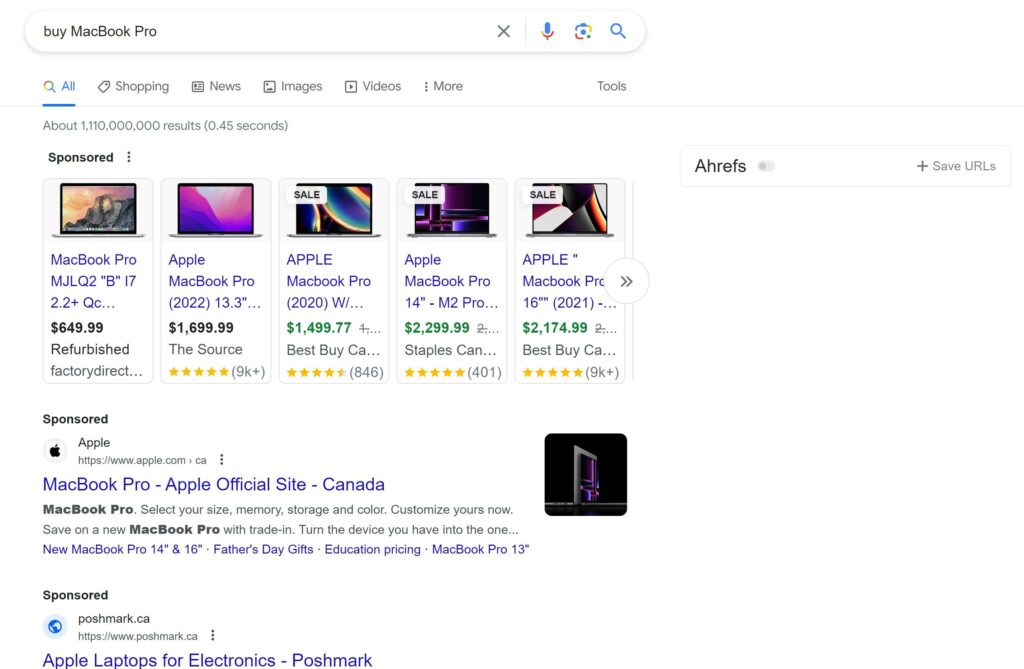
Another difference between commercial intent keywords and other types of keywords is their targeting potential. Businesses can use these kinds of target-specific keywords to reach audiences more likely to convert into customers.
Commercial Search Intent: Characteristics
When someone searches for a product or service with the intention of making a purchase, it is known as commercial search intent.
The user’s behavior differs when searching with a commercial intent compared to informational search intent. They are looking for specific actions such as buying, bidding, or comparing prices.
People who have commercial search intent are not just browsing; they have the intention to buy something. It is essential to understand their needs and provide the relevant information to help them make informed decisions.
Commercial intent keywords typically have some common characteristics:
- Specificity: They tend to be more specific than other types of keywords.
- High buying potential: People using these kinds of search terms have high buying potential.
- High competition: Commercial intent keywords are highly competitive due to their high buying potential.
In addition, commercial search intent has some distinct characteristics that differentiate it from other types of searches. These include:
- Specific keywords: People use specific keywords such as “buy,” “sale,” “bid,” or “compare” when searching with commercial intent. For example, “buy MacBook Pro“.
- Brand names: People often include brand names in their search queries when they have a specific brand in mind. For example, “Samsung galaxy watch 5 discounts“.
- Comparison: Users may compare different products or services before purchasing. For example, “galaxy watch 5 vs watch 4“.
- Features: People want to know about the features and specifications of the product or service they intend to buy. For example, “surface book battery life“.
- Time sensitivity: Many users are time-sensitive and want to make purchases soon.
Examples of commercial intent keywords include:
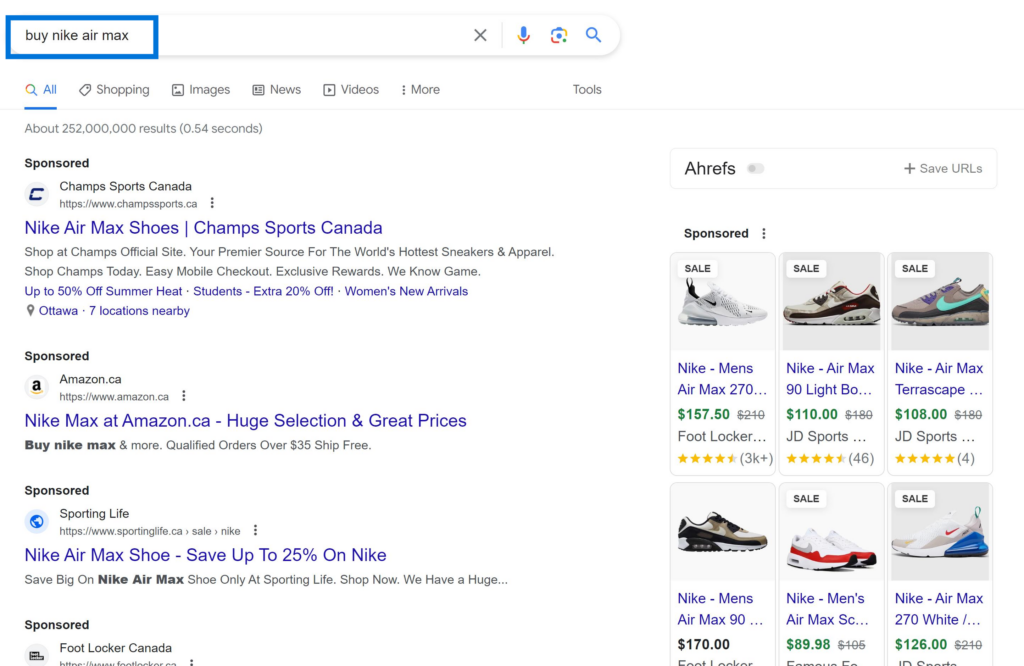
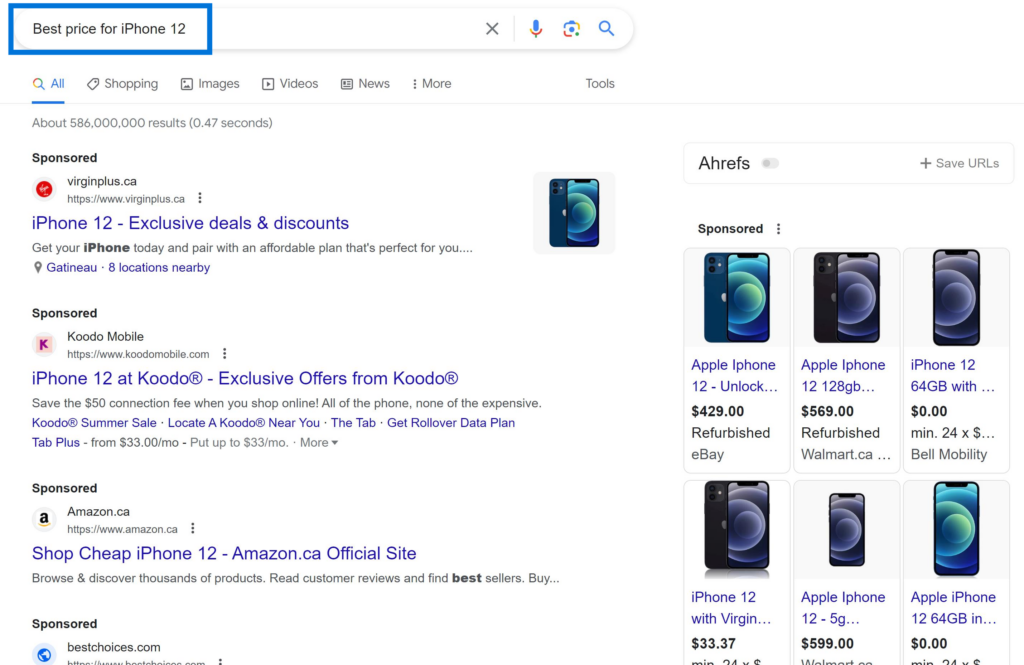
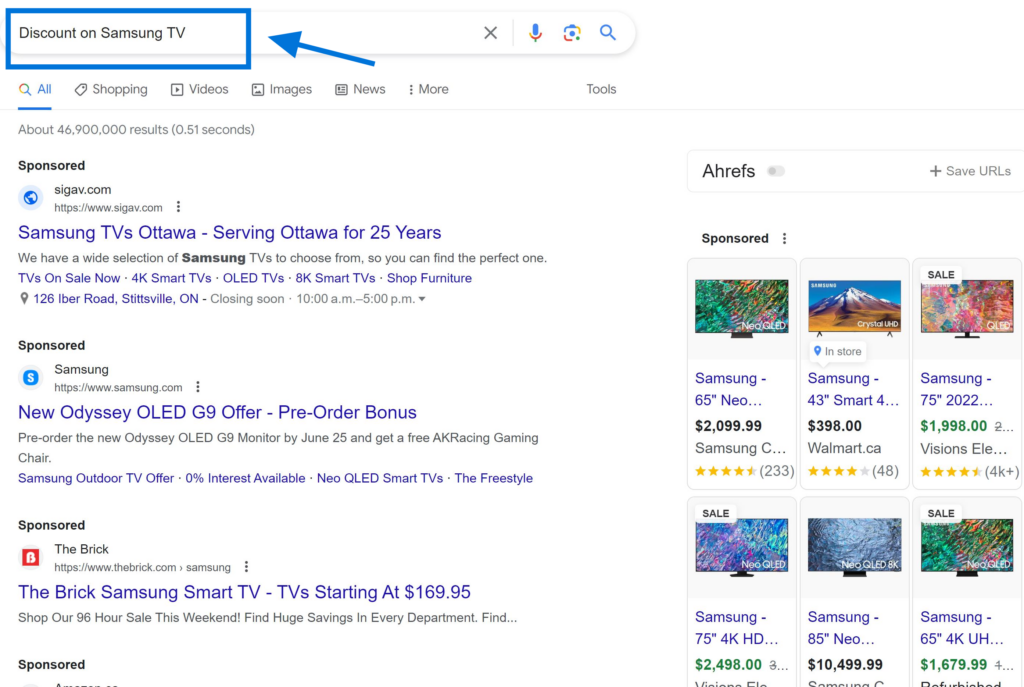
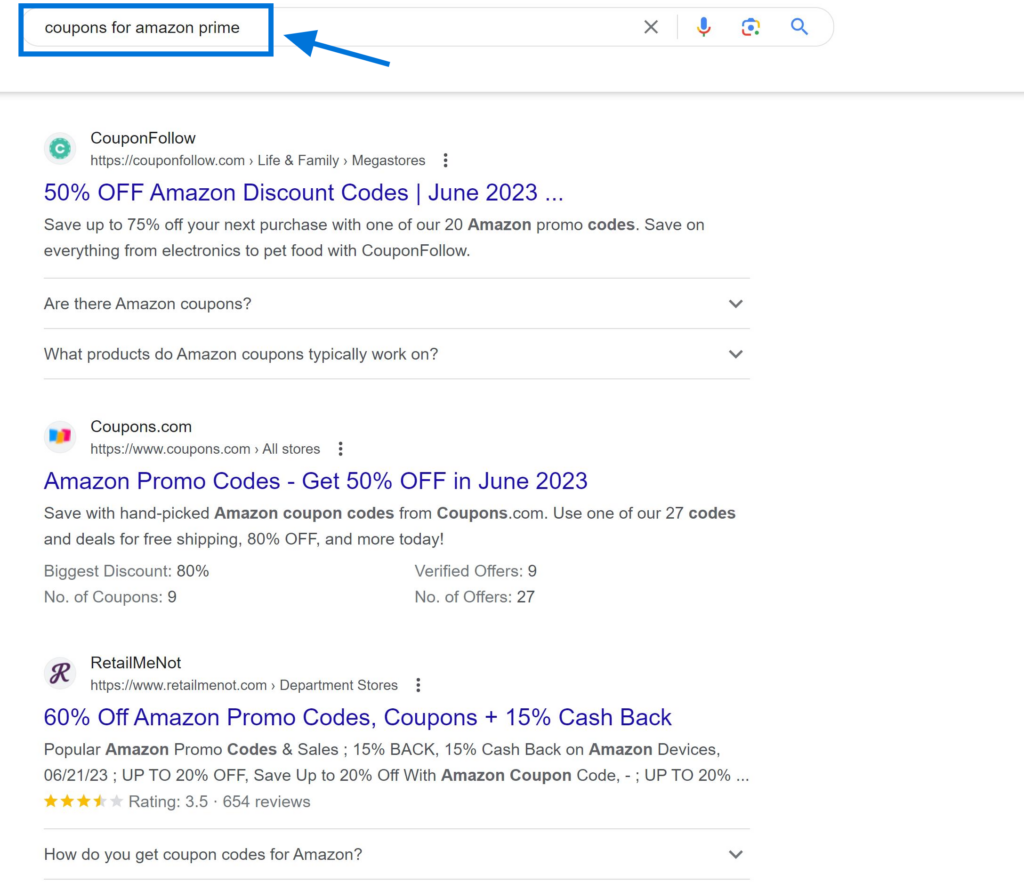
Commercial intent keywords are vital in driving sales and revenue for businesses. By focusing on these particular keywords, companies can connect with people who are more inclined to become paying clients.
This targeted approach to marketing helps businesses save money on advertising while increasing their conversion rates.
Understanding User Needs for Commercial Search Intent
To fulfill user needs based on their search intent types, businesses must first understand what their customers are looking for.
One way to do this is by analyzing search queries related to your business niche.
For example, if you sell cameras online, you could look at the most searched-for camera models and create content around those models’ features. This way, potential customers will find your website when searching for those particular models.
Businesses can also create targeted content that caters specifically to users’ needs with commercial search intent. For instance:
- A list of top-rated cameras
- A comparison chart between different camera brands
- A guide on how to choose the best camera for your needs
- An article on how cameras work and what features to look for
Examples of Fulfilling User Needs
Businesses can fulfill user needs through various means. Here are some examples:
- E-commerce websites can have a “Sale” section where users can find discounted products.
- Companies can create videos showcasing their products’ features and how they compare to other brands.
- Brands can create blog posts or articles that help users make informed decisions when buying products or services.
- Websites can offer free trials or demos to entice potential customers.
Businesses are more likely to convert potential customers into paying ones if they fulfill the users’ needs.
Commercial Search Intent vs. Commercial Investigation Search Intent
Commercial search intent refers to a user’s intention to purchase a product or service.
This type of search is done to find something specific to buy. The user has already decided that they want to make a purchase and are looking for the best option available.
On the other hand, commercial investigation search intent refers to a user’s intention to research products or services before making a purchase decision.
This type of search is done with the goal of gathering information about different options before deciding which one to buy.
To illustrate the differences between these two types of searches, let’s look at some examples:
Commercial Search Intent
In these examples, the user has already decided what they want to buy and is searching for specific products or services.
Commercial Investigation Search Intent
In these examples, the user is still in the research phase and is looking for information about different products or services before making a purchase decision.
Targeting Each Type Effectively
Understanding the difference between commercial search intent and commercial investigation search intent is crucial.
For businesses targeting users with commercial search intent, optimizing their website and product pages with relevant keywords that match what users are searching for is essential.
By implementing this strategy, businesses can increase their visibility on search engine results pages (SERPs) and improve their chances of attracting customers who are searching for specific products.
For businesses targeting users with commercial investigation search intent — creating content that provides valuable information about their products or services is important.
It can include product comparisons, reviews, and guides that help users make informed purchase decisions.
It’s also important to note that many users may start with commercial investigation search intent but convert with commercial search intent.
Therefore, businesses should have a strategy to effectively target both types of searches.
Examples of Commercial Intent Keywords
Commercial intent keywords refer to search terms that indicate a user’s intention to make a purchase or engage in a transaction.
These types of keywords are essential for businesses looking to attract customers who are ready to buy.
E-commerce Commercial Intent Keywords
E-commerce websites rely heavily on commercial intent keywords to drive traffic and sales.
Some examples of high-commercial-intent e-commerce keywords include:
- Buy [product name]
- Discounted [product name]
- Best deals on [product category]
These types of keywords signal that the user is actively searching for products to purchase and is likely close to making a buying decision.
By targeting these specific phrases, e-commerce businesses can increase their chances of converting website visitors into paying customers.
Healthcare Commercial Intent Keywords
The healthcare industry also benefits from using commercial intent keywords in its marketing efforts.
Some examples of high-commercial-intent healthcare keywords include:
- “Find a doctor near me.”
- “Book appointment online”
- “Compare health insurance plans.”
These types of phrases indicate that the user is interested in taking action related to their health, whether it be finding a provider or purchasing insurance coverage.
By optimizing content around these specific phrases, healthcare businesses can attract potential patients and provide them with the information they need to make informed decisions.
Travel Commercial Intent Keywords
Travel companies can also benefit from targeting commercial intent keywords in their marketing campaigns.
Some examples of high-commercial-intent travel keywords include:
- “Cheap flights to [destination]”
- “Best hotels in [city]”
- “Vacation packages under $500”
These search phrases suggest that the user is actively planning a trip and looking for options within their budget.
By creating content around these specific phrases, travel companies can attract potential customers ready to book their next vacation.
Why Targeting High-Commercial-Intent Keywords is Important
Targeting high-commercial-intent keywords can help businesses achieve their goals by attracting potential customers ready to purchase or engage in a transaction.
By optimizing content around these specific phrases, businesses can increase their chances of converting website visitors into paying customers.
For example, if an e-commerce business optimizes its product pages for phrases like “buy [product name]“ and “discounted [product name],” they are more likely to attract users who are ready to make a purchase.
Similarly, if a healthcare business creates content around phrases like “book appointment online” and “compare health insurance plans,” they can attract potential patients who are actively seeking care.
Tips for Creating Content that Targets High-Commercial-Intent Keywords
When creating content that targets high-commercial-intent keywords, it’s essential to keep the following tips in mind:
- Conduct keyword research: Use tools like Google Keyword Planner or SEMrush to identify high-commercial-intent keywords related to your industry.
- Optimize on-page elements: Ensure that your title tags, meta descriptions, and headers include the target keyword.
Identifying and Analyzing Commercial Keywords
Techniques for Identifying High-Commercial-Intent Keywords Using Various Tools Such as Google Trends or Ahrefs.
Keyword research is a crucial part of any successful SEO strategy. However, not all keywords are created equal. Some keywords have higher commercial intent than others, which is more likely to lead to a sale or conversion.
One way to identify high-commercial-intent keywords is using keyword research tools such as Google Trends or Ahrefs. These tools allow you to see search volume trends over time and identify which keywords have the highest search volume and competition.
Another technique for identifying commercial keywords is by analyzing long-tail product keywords that include descriptive terms about specific products or services.
For example, instead of targeting the broad keyword “shoes,” try targeting “women’s running shoes” or “leather dress shoes for men.”
These long-tail product keywords are more likely to lead to a sale because they indicate that the user is looking for something specific.
Strategies for Analyzing Competitors’ Use of High-Commercial-Intent Keywords.
By examining the use of high-commercial-intent keywords by your competitors, you can gain valuable insights into successful tactics within your industry. This knowledge can help you pinpoint areas where your own strategy falls short and uncover fresh prospects for reaching potential customers.
One way to analyze your competitors’ use of commercial keywords is by conducting a competitor analysis using tools like SEMrush or Ahrefs.
These tools allow you to see which organic search and paid search terms your competitors are ranking for, giving you an idea of which high-commercial-intent keywords they’re targeting.
Another strategy is looking at their website and social media content.
Are they consistently using certain product-related words?
Do they have landing pages optimized around specific products?
By analyzing their content, you can get a better sense of which commercial terms they’re prioritizing.
Importance of Understanding User’s Search Queries to Identify Relevant High-Commercial-Intent Keyword Opportunities.
Understanding the intent behind a user’s search query is key to identifying relevant high-commercial-intent keyword opportunities.
By analyzing the language users are using in their searches, you can identify which keywords have the highest commercial intent and tailor your content accordingly.
One way to understand user intent is by researching keywords with tools like Google Keyword Planner or Moz Keyword Explorer. These tools allow you to see which keywords users search for and how competitive they are.
Another strategy is to look at users’ questions about your product or service.
By analyzing forums, social media channels, and Q&A sites like Quora, you can better understand what types of questions users have about your industry. This information can help you identify new high-commercial-intent keyword opportunities you may have yet to think otherwise.
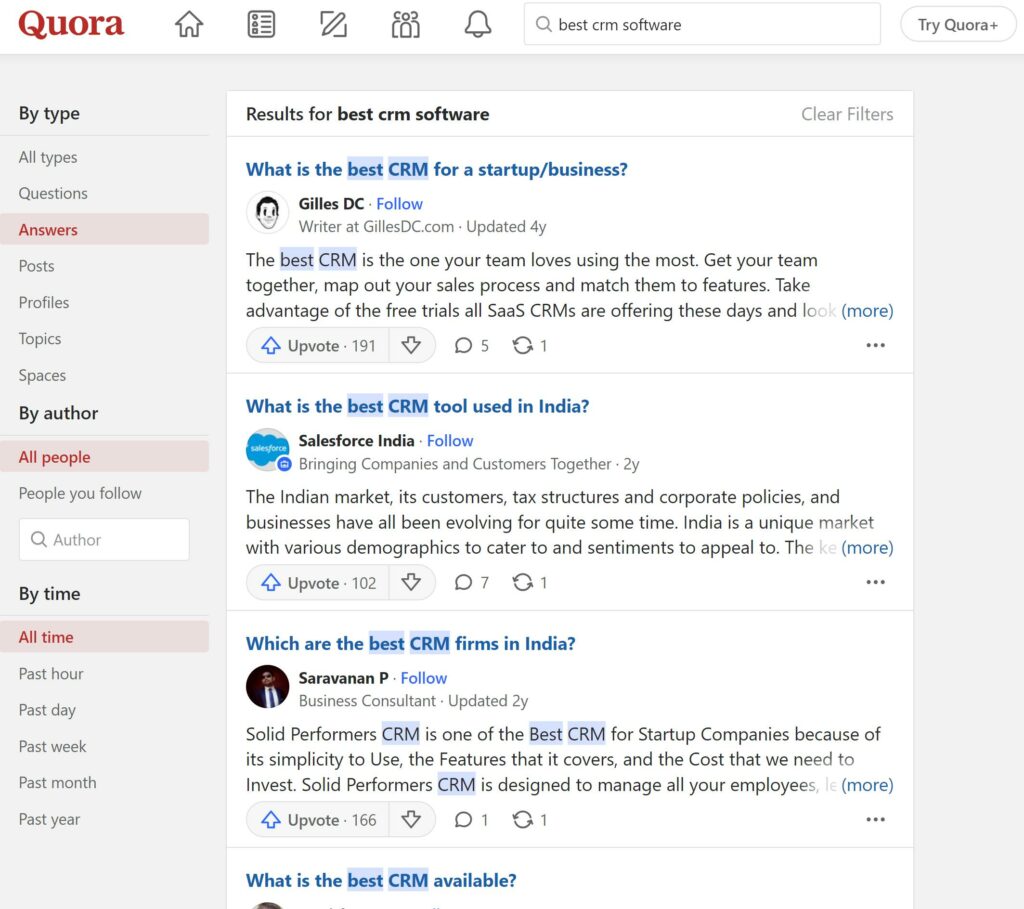
Once you’ve identified a list of potential high-commercial-intent keywords, it’s important to prioritize which ones to target first based on factors like competition level and search volume.
Understanding and Utilizing Commercial Search Intent
One of the most important aspects of SEO is understanding user intent. By understanding what users are searching for, businesses can optimize their websites to fulfill those needs better.
By understanding commercial search intent, businesses can create a more effective SEO strategy that targets these valuable users.
Creating Content that Aligns with User Needs
Businesses need to produce content that meets the requirements of their target audience to enhance their online visibility.
For commercial search intent, this means creating content that fulfills users’ search queries and provides them with the information they need to make an informed decision.
This could include product descriptions, reviews, comparisons, and other relevant information.
To create compelling content for commercial search intent, businesses should consider the following tips:
- Conduct keyword research to identify relevant keywords and phrases.
- Analyze competitor content to see what topics and formats are performing well.
- Use clear headings and subheadings to organize content.
- Incorporate multimedia such as images and videos to enhance the user experience.
- Make sure the content is easy to read and understand.
Optimizing Website Design and User Experience
Optimizing website design and user experience is another important aspect of targeting commercial search intent.
Users who are looking to make a purchase or engage in some form of commercial activity want a seamless experience that makes it easy for them to find what they’re looking for.
To optimize the website design and user experience for commercial search intent, businesses should consider the following tips:
- Make sure website navigation is clear and intuitive.
- Use high-quality images and videos that showcase products or services.
- Ensure website speed is fast by optimizing images, code, server response time, etc.
- Implement responsive design so that the site looks good on all devices (mobile-friendly).
- Provide clear calls-to-action (CTA) that encourage users to take action.
Creating a comprehensive SEO strategy that targets commercial search intent requires a multi-faceted approach. Businesses must consider all aspects of their online presence, including website design, content creation, and keyword research.
Creating a Comprehensive SEO Strategy
To create a comprehensive SEO strategy for commercial search intent, businesses should consider the following tips:
- Conduct thorough keyword research to identify relevant keywords and phrases.
- Optimize website design and user experience to maximize engagement and conversions.
- Create high-quality content that aligns with user needs.
- Build quality backlinks from reputable websites in your niche or industry.
- Monitor and regularly analyze performance metrics such as traffic, bounce rates, click-through rates, etc.
High Commercial Intent Keywords: Keyword Magic Tool and Google Ads Keyword Planner
Explanation of How These Tools Work
Keyword research is an essential part of any successful digital marketing strategy. It helps you understand what phrases people search for and how often they search for them.
Two popular keyword research tools are the Keyword Magic Tool by SEMrush and the Google Ads Keyword Planner.
The Keyword Magic Tool allows users to enter a seed keyword and generate a list of related keywords with various metrics such as search volume, difficulty level, CPC, and more. The tool also provides suggestions based on user intent, questions, and comparisons.
The Keyword Magic Tool provides more detailed information about keyword variations and suggestions based on user intent, questions, and comparisons. It also offers a wider range of metrics, such as SERP features, related keywords, and phrase matches.
On the other hand, Google Ads Keyword Planner is designed to help advertisers find keywords to target in their ad campaigns. It provides:
- Data on search volume trends.
- Competition levels.
- Suggested bids.
- Estimated clicks for each keyword.
Google Ads Keyword Planner is designed specifically for advertisers to target keywords in ad campaigns. It provides data on estimated clicks, suggested bids, and competition levels for each keyword. It also offers historical data on search volume trends.
How They Can Help Identify High-Commercial-Intent Keywords
High commercial intent keywords indicate a user’s intention to purchase or take action. These keywords have high conversion rates but may also have higher competition levels.
Both the Keyword Magic Tool and Google Ads Keyword Planner can help identify high-commercial-intent keywords.
Advertisers can determine which keywords will likely drive conversions by analyzing cost-per-click (CPC), estimated bid value, and competition level.
For example, if you’re selling running shoes online, using the Keyword Magic Tool or Google Ads Keyword Planner could help you discover that “buy running shoes,” “best running shoes,” or “discounted running shoes” are high-commercial-intent keywords that would be worth targeting in your ad campaigns.
To use these tools effectively:
- Start with a clear understanding of your target audience and their needs.
- Use broad match terms when searching for seed keywords.
- Analyze keyword metrics such as search volume trends, CPCs, and competition levels.
- Consider long-tail keywords that have lower competition but higher commercial intent.
- Use negative keywords to exclude irrelevant or low-commercial-intent searches.
- Continuously monitor and adjust your keyword strategy based on performance metrics.
Lead vs. Product Searches and Product/Service Commercial Intent Keywords
There are two main types of searches: lead and product searches.
Lead searches are broad searches where the user seeks information or solutions to a problem. In contrast, product searches are specific searches where the user is looking for a particular product or service.
Understanding the difference between these two types of searches is crucial when targeting specific products or services with commercial intent keywords.
Definition of Lead vs. Product Searches
Lead searches are general in nature and can include anything from informational articles to how-to guides. These types of searches usually involve a question or problem the user needs help solving.
For example, if someone is searching for “how to care for fiddle leaf fig,” they are likely conducting a lead search.
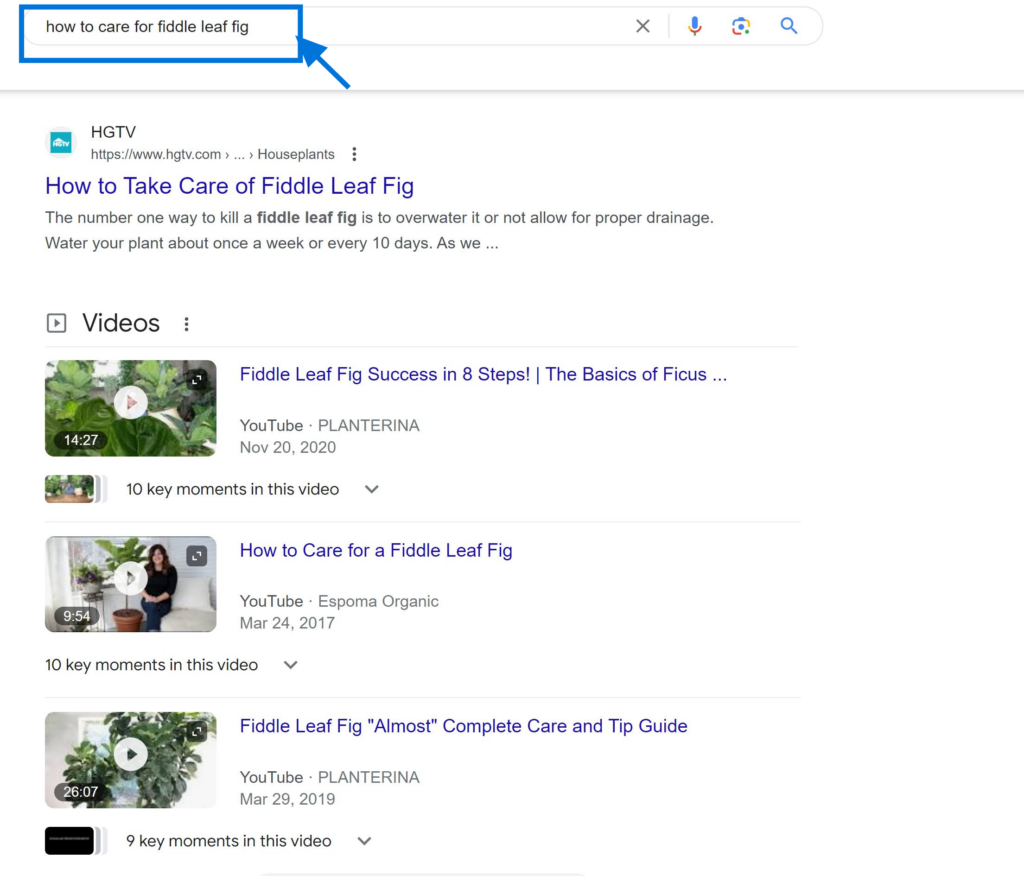
On the other hand, product searches are more specific and involve searching for a particular product or brand name. For instance, if someone is searching for a “fiddle leaf fig plant,” they perform a product search.
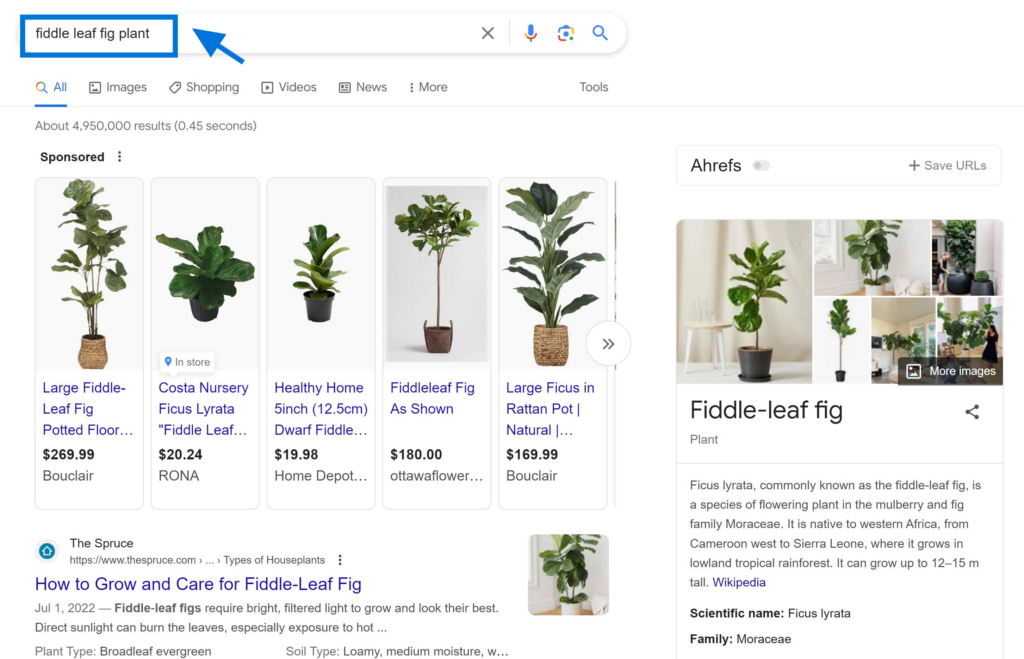
Examples of Product/Service Commercial Intent Keywords in Both Types of Searches
When targeting commercial search intent, it’s essential to use relevant keywords that will attract potential customers who intend to buy your products or services.
Here are some examples of commercial intent keywords that can be used in both lead and product searches:
- Best fiddle leaf fig soil
- Buy fiddle leaf fig online
- Fiddle leaf fig sale
- Fiddle leaf fig delivery
- Fiddle leaf fig care services
By incorporating these keywords into your website copy and product pages, you can increase your chances of attracting potential customers interested in purchasing your products or services.
Understanding How to Target Each Type Effectively for Maximum Impact on Business Goals
To effectively target each type of search query, it’s important to understand what users are looking for when conducting each search type.
When targeting lead searches, it’s important to provide informative content that answers the user’s questions and helps solve their problems. This can include blog posts, how-to guides, and informational articles.
When targeting product searches, it’s important to create product pages that are optimized for specific keywords related to your products or services.
These pages should include detailed descriptions of your products or services, high-quality images, and customer reviews.
The Role of Long-Tail Keywords in Targeting Specific Products or Services
Long-tail keywords are longer phrases that are more specific in nature. They can be used to target specific products or services and help attract potential customers who intend to buy.
For example, instead of using the keyword “fiddle leaf fig,” you could use a long-tail keyword like “buy fiddle leaf fig online” or “best fiddle leaf fig soil.”
By incorporating long-tail keywords into your website copy and product pages, you can increase your chances of attracting potential customers specifically looking for your products or services.
Optimizing for Commercial Search Intent
Techniques for Optimizing Website Content, Meta Tags, and Descriptions to Target High-Commercial-Intent Keywords
Optimizing for commercial search intent is essential. Commercial search intent refers to users looking to purchase or take other transactional actions.
To optimize your website for commercial search intent, you need to focus on the following:
- Keyword research: Start by researching high-commercial-intent keywords that are relevant to your business. Use tools like Google Keyword Planner or Ahrefs to identify these keywords.
- Content marketing: Craft high-quality content that focuses on high-commercial-intent keywords. This approach will elevate your ranking in the SERPs and draw in a greater volume of organic traffic.
- Meta tags and descriptions: Optimize your meta tags and descriptions with the same high-commercial-intent keywords. This will help improve click-through rates (CTRs) from the SERPs.
Importance of Mobile Optimization for Commercial Search Intent
Mobile optimization is crucial. More than half of all internet traffic now comes from mobile devices, so if your website isn’t optimized for mobile, you’re missing out on a significant amount of potential traffic.
To optimize your website for mobile:
- Choose a responsive design that adapts automatically to different screen sizes.
- Optimize images and videos for faster load times on mobile devices.
- Ensure all buttons and links are large enough and easy to click on smaller screens.
- Use clear, concise language that’s easy to read on small screens.
Strategies for Improving Website Speed and Performance to Enhance User Experience
Website speed is another critical factor. Users expect fast-loading websites, so if your site takes too long to load, they’ll likely abandon it in favor of a faster option.
To improve website speed:
- Use a content delivery network (CDN) to distribute your website’s content across multiple servers.
- Optimize images and videos for faster load times.
- Minimize HTTP requests by combining CSS and JavaScript files.
- Enable browser caching to reduce the number of requests made to your server
Tips for Measuring Success Through Analytics and Adjusting Strategies Accordingly
To ensure your efforts pay off, you must measure your success regularly. Use tools like Google Analytics or Google Search Console to track essential metrics like search volume, traffic sources, bounce rates, and conversion rates.
Based on these metrics, adjust your SEO strategy accordingly. For example:
- Adjust your content marketing strategy to target these keywords more effectively if you’re not getting enough organic traffic from high-commercial-intent keywords.
- If users bounce off your landing pages quickly, improve the user experience by optimizing page speed and layout.
- If you’re not seeing enough conversions from organic traffic, consider running ads or targeting more navigational queries that lead users further down the marketing funnel.
Following these tips and techniques for optimizing commercial search intent can attract more organic traffic to your website and increase conversions.
Additional FAQs on Commercial Search Intent
How Do I Identify High Commercial Intent Keywords?
You can use tools like Keyword Magic Tool or Google Ads Keyword Planner to identify high commercial intent keywords based on factors such as search volume, competition level, cost-per-click (CPC), and relevance to your business.
What Types of Businesses Should Focus on Optimizing for Commercial Search Intent?
Any business offering products or services for sale online should optimize for commercial search intent.
How Can I Optimize My Website for Product/service Commercial Intent Keywords?
You can optimize your website by creating targeted landing pages with relevant content related to specific product/service searches, including clear calls-to-action (CTAs) that encourage users to make a purchase or request more information.
What Are Some Common Mistakes Businesses Make When Targeting Commercial Search Intent?
Some common mistakes include using irrelevant or low-intent keywords, not having clear CTAs on landing pages, and not continually analyzing and adjusting their strategy based on data-driven insights.
How Can I Track the Success of My Commercial Search Intent Optimization Efforts?
You can track the success of your efforts by monitoring metrics such as click-through rate (CTR), conversion rate, and revenue generated from commercial intent keywords. This will help you identify areas for improvement and make data-driven decisions to optimize your strategy further.
Is It Necessary to Use Paid Advertising to Target Commercial Search Intent?
While paid advertising can effectively target high commercial intent keywords, it is not always necessary.
Optimizing your website for these keywords and creating targeted content can also be effective in reaching potential customers who are ready to make a purchase.
How Often Should I Analyze My Commercial Search Intent Strategy?
You should continually analyze and adjust your strategy based on data-driven insights.
However, the analysis frequency may depend on factors such as the size of your business and the level of competition in your industry.
Conclusion: Understanding and Utilizing Commercial Search Intent
Understanding commercial search intent is crucial for businesses to succeed in their online marketing efforts.
By identifying and analyzing high commercial intent keywords, businesses can optimize their content and advertising strategies to target potential customers ready to purchase.
We have also highlighted tools such as Keyword Magic Tool and Google Ads Keyword Planner that can help identify high commercial intent keywords.
Furthermore, we have emphasized the importance of optimizing for product/service commercial intent keywords and provided tips on how to do so effectively.
By understanding and utilizing commercial search intent effectively, businesses can increase their chances of reaching potential customers ready to purchase. It is essential to continually analyze and adjust your strategy based on data-driven insights.
